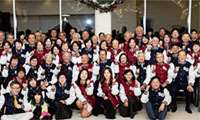An Oven of Ancient India, Now Available at Home
In fact, he had never heard of tandoors - Indian clay cooking vessels - until 1986, when a New York gallery exhibited his two-meter pots, inspired by amphorae on Crete. A man with an Indian accent called, asking if Mr. Levy, a ceramic artist, could make a large pot with a tapered mouth, no bottom and no glaze: a tandoor.
After it was installed at a New York restaurant , word spread through the Indian community, and orders began to pile up.
“It came to the point where I had to stop doing my ceramic artwork, and focus on tandoors full time,” Mr. Levy, 63, recalled.
He converted his New York studio into a tandoor factory. Over the past 30 years, he has built more than 2,000 for restaurants across North America, and as far away as Mexico, Belize and Fiji.
“Coming from a fine arts background, it was very satisfying to make something so functional ,” Mr. Levy said. “I think of it as ceramics that feeds the body, in addition to soothing the soul.”
Now he has developed a tandoor for home use, the Homdoor. It starts at $1,200.
One of them sits just outside his studio on Islamorada in the Florida Keys, where he now lives.
Michael Ledwith, the chef of Hungry Heron Catering nearby, recently threaded spice-crusted rectangles of steak onto metal skewers. The beef came out of the tandoor’s blast-furnace heat with an explosively flavorful crust and uncommonly succulent center.
The traditional tandoor was typically an unfired vessel, the clay walls strengthened with straw and animal hair.
“It was very unsanitary,” Mr. Levy said, adding that ovens shipped to the United States “often arrived from India broken, or would crack with extended use.”
His first innovation was to fashion the body from a blend of earthenware and stoneware, the latter for its ability to withstand high heat without cracking. For porosity (an essential quality so that flatbreads can cling to the inner walls), he added finely ground fired clay. For insulation and strength, he developed a clay and vermiculite mixture that could be baked onto the exterior.
Finally, he devised a sturdy stainless steel housing.
“We’ve been using Ron’s tandoors for the last 20 years,” said Vicky Vij, an owner of Bukhara Grill and Dawat in Manhattan. “They outlast any Indian clay tandoor. They’re masterpieces.” After the pots are formed, each is turned on a giant wheel to smooth the interior. The tandoors are dried, then baked at 1,100 degrees Celsius for seven hours. The process takes about two weeks.
The tandoor may have originated in Rajasthan, India, where archeologists have found tandoor remains dating from 2600 B.C. - about the same time as the pyramids. The first tandoors were used to bake flatbread, a tradition that survives in Indian roti, Afghan naan and Turkmen chorek.
The tandoor is the preferred barbecue pit throughout Central and South Asia and the Caucasus region. Iranians call it tanoor; Uzbeks, tandyr; Azerbaijanis, tandir; Armenians, tonir; and Georgians, tone. But the center of tandoori cooking is Punjab. The tandoor’s shape, a cylinder with sloped walls, has remained essentially unchanged for 5,000 years.
Despite its simplicity, it produces startlingly sophisticated results.
According to Mr. Levy, tandoor cooking uses four distinct techniques. Direct heat rises from the charcoal, akin to grilling. The hot clay walls cook bread, similar to skillet-roasting. Radiant heat produces results similar to convection baking. And smoke adds fragrance and flavor.
Because of its design - a vent at the bottom draws air, and the inward slope of the mouth traps the heat - a tandoor can reach 260 to 400 degrees Celsius . Mr. Levy uses a propane burner that can heat ceramic briquettes ; the Homdoor, available at homdoor.com, also burns charcoal.
The final challenge was production. Mr. Levy made his commercial tandoors in small batches as orders arrived. His business plan for the Homdoor calls for 500 units to be built the first year. Last year, he joined forces with a ceramics company in Uhrichsville, Ohio.
The company has built 50 Homdoors. Mr. Levy was so pleased with the result that all of his tandoors are now made in Ohio.
Madhur Jaffrey, the actress and Indian cooking authority, had never heard of a tandoor growing up in Delhi. When she discovered tandoori chicken, robustly seasoned and dyed orange with food coloring, it was a revelation.
“It was totally exotic - meat cooked to order for just a few minutes,” she recalled. “We Indians were so used to cooking meat to death.”
By STEVEN RAICHLEN
스마터리빙
more [ 건강]
[ 건강]이제 혈관 건강도 챙기자!
[현대해운]우리 눈에 보이지 않기 때문에 혈관 건강을 챙기는 것은 결코 쉽지 않은데요. 여러분은 혈관 건강을 유지하기 위해 어떤 노력을 하시나요?
 [ 건강]
[ 건강]내 몸이 건강해지는 과일궁합
 [ 라이프]
[ 라이프]벌레야 물럿거라! 천연 해충제 만들기
 [ 건강]
[ 건강]혈압 낮추는데 좋은 식품
[현대해운]혈관 건강은 주로 노화가 진행되면서 지켜야 할 문제라고 인식되어 왔습니다. 최근 생활 패턴과 식생활의 변화로 혈관의 노화 진행이 빨라지고
사람·사람들
more많이 본 기사
- “트럼프, 바이든 데자뷔인줄” 취임 1년새 고령 논란·지지율 뚝
- “머스크처럼…” 미국인 대리모 통해 2세 퍼트리는 中재벌
- 윤영호, ‘플리바게닝’ 노렸나…자충수 된 ‘민주당 금품’ 진술
- 도쿄행 유나이티드 항공편, 엔진 고장에 워싱턴으로 회항
- ‘단 4개월 만에’ 손흥민 美 정복, MLS 공식 ‘올해의 영입 2위’... “리그 판도 뒤바꿔”
- 경찰직무집행법 통과로 1차 필버 종료…연말 ‘필버 재격돌’ 전망
- 내년 중간선거 낙관못하는 트럼프… “경제성과 전달에 시간 걸려”
- ‘무려 키패스 3회+평점 8.2’ 이강인 특급 맹활약, 5호 공격P 작렬... ‘간신히’ PSG 선두 탈환
- 바비킴, 15년 만에 ‘기내 난동 논란’ 재언급.. “공격적 태도 사과하고파”
- 김지수, 꿀꿀했던 韓 떠났다.. “에펠탑 보니 메마른 낭만 살아나”
- 주말 濠·美서 총기사건…시드니 11명·브라운대 2명 사망
- [특파원시선] 외식비 줄이는 미국… ‘30% 요구’ 팁 공포도 한몫?
- “사초 쓰겠다”던 내란특검 ‘180일 대장정’ 마침표…24명 재판에
- 내년 중간선거 낙관못하는 트럼프… “경제성과 전달에 시간 걸려”
- 주말 濠·美서 총기사건…시드니 11명·브라운대 2명 사망
- 트럼프 특사·젤렌스키 ‘베를린 회동’…우크라 종전안 진전되나
- 뉴욕 백화점서 아기 기저귀 갈던 엄마, 정신질환자에 흉기피습
- ‘손흥민 벽화 3일 만에 그린’ 예술가, SON과 감격 만남 후 “내 아들의 영웅이자 아시아 유산” 찬사
- 인도 투어 나선 축구스타 메시…경기장 조기 퇴장에 팬들 난동
- 정용진 신세계그룹 회장, 밴스 부통령 성탄절 만찬 참석
- 김연아♥고우림, 사랑하니 닮아가네..예쁜 커플사진
- 1124일만 선고.. ‘20억 횡령 인정’ 박수홍 친형 결론은?
- ‘연준의장 후보’ 해싯 “대통령 목소리는 의견일뿐…FOMC가 투표”
- 변요한♥티파니, 약지에 ‘커플링·포르쉐’..열애 中 티냈다
- 韓 탁구 최초 역사… 신유빈-임종훈, 세계랭킹 1위+파리올림픽 金 듀오 꺾고 WTT 파이널스 우승
- 10석 안팎까지?…내년 한국 지방선거 때 ‘미니 총선급’ 재보선 가능성
- ‘김민재 점점 독일 국대에 밀린다’ 독일 현지, 타 향해 연일 찬사... “뮌헨 최고의 영입, 진정한 수비 리더”
- 오세훈 “내집 마련 꿈, 10·15대책에 짓밟혀…규제 완화해야”
- 조미김, 미국 수출관세 ‘면제’됐다…K-김 최대시장서 날개
- 지선 손 맞잡을까…통일교 특검으로 거리 좁히는 국힘·개혁신당
- 한소희, 韓 떠나기 전 의미심장 SN… 1
- 내란특검, 김용현 추가 기소… “HID요원 등 명단 노상원에 넘겨”
- 연말연시 과음 후 속쓰림…단순숙취? “급성염증 신호일수도”
- 아이비리그 브라운대서 총격…최소 2명 사망, 8명 중상
- “다카이치 ‘대만발언’은 對中전략 부재 탓…정상 만나야 해결”
- ‘인니 수마트라섬 대홍수’ 사망자 1천명 넘어…218명 실종
- 與, 은행법 처리뒤 ‘경찰관직무집행법… 2
- 이정후 태극마크 ‘청신호’ 떴다! 스타 출신 SF 사장 “야수보단 투수가 WBC 위험”→걸림돌 사라졌다
- 트럼프 “태국·캄, 교전 중단 합의”… 1
- 美, 카리브해 군사자산 확대… “베네수엘라에 지상·전자전 위협”
- AI 시장 흔들렸다…챗GPT 독주 속 제미나이 급부상
- 트럼프, 시리아서 IS 공격으로 美병사 사망하자 “강력 보복”
- 국방부 “시리아서 공격받아 미군 2명 사망…공격범 사살”
- ‘아프리카에 당한 기억’ 홍명보, ‘1승 제물’ 남아공 경계했다... 박문성도 “2014 월드컵 악몽 떠올라”
- 시리아서 미군 피격, 3명 사망… “시리아군 내 극단주의자 소행”
- 트럼프 “인디애나 선거구 조정 반대한 공화의원들, 교체돼야”
- 아이비리그 브라운대서 총격…최소 2명 사망, 8명 중상
- 트럼프 “인디애나 선거구 조정 반대한 공화의원들, 교체돼야”
1/5지식톡

-
 테슬라 자동차 시트커버 장착
0
테슬라 자동차 시트커버 장착
0테슬라 시트커버, 사놓고 아직 못 씌우셨죠?장착이 생각보다 쉽지 않습니다.20년 경력 전문가에게 맡기세요 — 깔끔하고 딱 맞게 장착해드립니다!장착비용:앞좌석: $40뒷좌석: $60앞·뒷좌석 …
-
 식당용 부탄가스
0
식당용 부탄가스
0식당용 부탄가스 홀세일 합니다 로스앤젤레스 다운타운 픽업 가능 안녕 하세요?강아지 & 고양이 모든 애완동물 / 반려동물 식품 & 모든 애완동물/반려동물 관련 제품들 전문적으로 홀세일/취급하는 회사 입니다 100% …
-
 ACSL 국제 컴퓨터 과학 대회, …
0
ACSL 국제 컴퓨터 과학 대회, …
0웹사이트 : www.eduspot.co.kr 카카오톡 상담하기 : https://pf.kakao.com/_BEQWxb블로그 : https://blog.naver.com/eduspotmain안녕하세요, 에듀스팟입니다…
-
 바디프렌드 안마의자 창고 리퍼브 세…
0
바디프렌드 안마의자 창고 리퍼브 세…
0거의 새제품급 리퍼브 안마의자 대방출 한다고 합니다!8월 23일(토)…24일(일) 단 이틀!특가 판매가Famille: $500 ~ $1,000Falcon: $1,500 ~ $2,500픽업 & 배송직접 픽업 가능LA…
-
 바디프렌드 안마의자 창고 리퍼브 세…
0
바디프렌드 안마의자 창고 리퍼브 세…
0거의 새제품급 리퍼브 안마의자 대방출 한다고 합니다!8월 23일(토)…24일(일) 단 이틀!특가 판매가Famille: $500 ~ $1,000Falcon: $1,500 ~ $2,500픽업 & 배송직접 픽업 가능LA…
케이타운 1번가
오늘의 1면
오피니언

22기 LA평통 출범에 거는 기대

연말 시즌 사기·범죄 경계해야
 메건 매카들 워싱턴포스트 칼럼니스트
메건 매카들 워싱턴포스트 칼럼니스트 [메건 매카들 칼럼] 장편영화의 마지막 챕터인가
 김미선 서북미문인협회 회장시인
김미선 서북미문인협회 회장시인 [한국춘추] 하늘을 계산한 사람들, 칠정산
 이희숙 시인·수필가
이희숙 시인·수필가 [금요단상] 그을린 자리에서 다시
 심상용 / 서울대 미술관장
심상용 / 서울대 미술관장 [미술 다시보기] 지옥에 대하여
 서정명 / 서울경제 기자
서정명 / 서울경제 기자[만화경] 주한미군과 ‘도련선 리스크’
 한 영 재미수필가협회 회장
한 영 재미수필가협회 회장 [한영의 독서칼럼] 불안한 사람들
 정영현 서울경제 테크성장부장
정영현 서울경제 테크성장부장 [여명] 콘크리트가 데이터가 됐을 뿐, 달라진 게 없다
1/3지사별 뉴스

“마약밀매·인신매매 등 국제범죄 척결” ‘국토안보 태스크포스’ 뉴욕지부 출범
연방 국토안보부가 10일 ‘국토안보 태스크포스’(HSTF) 뉴욕지부를 출범시켰다.HSTF는 마약 카르텔, 인신매매, 자금세탁, 갱단 등 국제범…
‘오바마케어 보조금’ 올해 말 종료 가능성 ↑ 커져

한국 교사 10명, 페어팩스 초등교 배치
‘글로벌 앰버서더 티처스 프로그램’(Global Ambassador Teachers Program)은 국제 교사 교환 프로그램 가운데 하나로 …
김찬수씨, 포토맥 포럼에 2천달러 기부

주말 濠·美서 총기사건…시드니 11명·브라운대 2명 사망
주말 미국과 호주에서 각각 10명 이상의 사상자가 나온 대형 총기 사건이 발생했다.14일(이하 현지시간) 호주의 유명 해변에서 약 1천명 참석…
내년 중간선거 낙관못하는 트럼프… “경제성과 전달에 시간 걸려”

오늘 하루 이 창 열지 않음 닫기 





















































.png)


댓글 안에 당신의 성숙함도 담아 주세요.
'오늘의 한마디'는 기사에 대하여 자신의 생각을 말하고 남의 생각을 들으며 서로 다양한 의견을 나누는 공간입니다. 그러나 간혹 불건전한 내용을 올리시는 분들이 계셔서 건전한 인터넷문화 정착을 위해 아래와 같은 운영원칙을 적용합니다.
자체 모니터링을 통해 아래에 해당하는 내용이 포함된 댓글이 발견되면 예고없이 삭제 조치를 하겠습니다.
불건전한 댓글을 올리거나, 이름에 비속어 및 상대방의 불쾌감을 주는 단어를 사용, 유명인 또는 특정 일반인을 사칭하는 경우 이용에 대한 차단 제재를 받을 수 있습니다. 차단될 경우, 일주일간 댓글을 달수 없게 됩니다.
명예훼손, 개인정보 유출, 욕설 등 법률에 위반되는 댓글은 관계 법령에 의거 민형사상 처벌을 받을 수 있으니 이용에 주의를 부탁드립니다.
Close
x